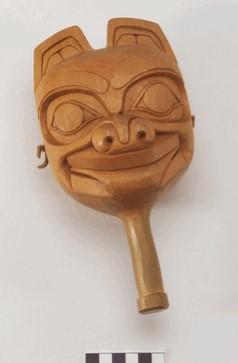Brown Bear Rattle
This rattle was shaped and then cut longitudinally from the top of the rattle all the way through the handle thus forming a front and back. Each round half was then hollowed out and selected stones from the gizzards taken from one or more Blue Grouse or Spruce Grouse were placed in these hollowed out cavities. Once the stones were placed the two halves would then be brought together and would be sewn or sealed so the stones could not fall out. These special stones usually of quartz gave a nice distinctive sound to the finished rattle. The rattle could be sewn with sinew, spruce root or leather. In this case Amos chose to use leather. Once the two halves were brought back together to form a single piece the details would be carved in with a curved knife to finish the design.
Amos chose to use typical characteristics that artists would use to represent a Brown Bear, a humanoid face, small ears on top of the head and a protruding tongue.
The brown bear is a crest for several Eagle clans. They have a special relationship with Tlingits as they are seen as their brothers and are benevolent when shown honor and respect.
Xoots (Brown Bear)
Xáay (Yellow Cedar)
du yoowú (gizzards)
Núkt (Blue Grouse)
Káax’ (Spruce Grouse)
té (stones)
tás (sinew)
dzaas (leather)
yoo kutan litaa (curved knife)
There are many stories about bears interacting with Tlingits and these are passed down from generation to generation. There was a time in the past that Tlingits believed that humans and brown bears could speak the same language. Most of the time both bears and humans could get along but every once in a while their disagreements could lead to mortal combat. The village of Hoonah was established in its current location because its previous location of Gaht heeni, after Xunaa Káawu left Glacier Bay, was favored by a community of bears who were not willing to share with humans. Humans had to move about a mile away to establish their own community. Balance would have to be restored so the conflict could be resolved, and both could continue to live in harmony. The brown bear was given the utmost respect and one should never gossip or talk badly about them, negative encounters were actually rare.
Rattle made of carved yellow cedar wood depicting a bear's head, with leather ties on the sides.
Acquired by Indian Arts and Crafts Board representatives in 1962 when the artist was employed during IACB arts and crafts
demonstrations at Juneau, Alaska; part of the IACB Headquarters collection (Department of the Interior, Washington, DC) until 2000
when it was transferred to NMAI.

